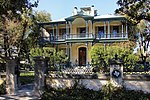Norton–Polk–Mathis House

The Norton–Polk–Mathis House, also known Villa Finale, is a historic house in San Antonio, Texas, United States. Local merchant Russel C. Norton began construction on the house in 1876. The house was designated a Recorded Texas Historic Landmark in 1971.It is a contributing property to the King William Historic District, which is listed on the National Register of Historic Places. It is also a National Trust Historic Site, the only one in Texas.The house was remodeled with additions of a second story, rear gallery, and Italian Renaissance Revival Tower. Other owners included rancher Edwin Polk and cattleman Ike T. Pryor. The house was then turned into a boarding house until 1967, when it was purchased by local civic leader Walter Nold Mathis. Mathis spent two years restoring the house and named it Villa Finale as he planned on it being his last home. He then purchased fourteen other homes in the King William neighborhood, restored them and sold them to others whom he hoped would continue to preserve them. The home was donated to the National Trust for Historic Preservation in 2004 which operates it as a museum.
Excerpt from the Wikipedia article Norton–Polk–Mathis House (License: CC BY-SA 3.0, Authors, Images).Norton–Polk–Mathis House
River Walk, San Antonio
Geographical coordinates (GPS) Address External links Nearby Places Show on map
Geographical coordinates (GPS)
| Latitude | Longitude |
|---|---|
| N 29.413888888889 ° | E -98.494166666667 ° |
Address
Villa Finale
River Walk
78205 San Antonio
Texas, United States
Open on Google Maps




